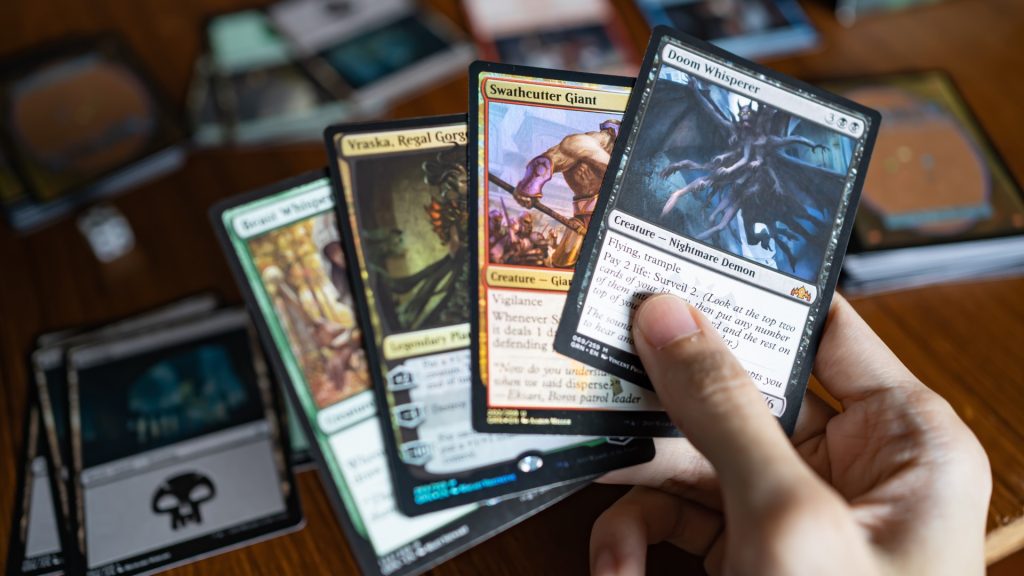What size are Magic: the Gathering Cards?

Magic: The Gathering (MTG) cards have a standard size, which is essential for gameplay, storage, and tournament play. This guide covers the key aspects related to the size of MTG cards, including dimensions, weight, sleeve compatibility, and comparison with other trading card games.
What Size are Magic: the Gathering Cards?
MTG cards are precisely measured at 63 mm by 88 mm (approximately 2.48 inches by 3.46 inches), a size that is slightly smaller than the often-quoted 2.5 inches by 3.5 inches. This exact sizing is vital for ensuring fairness during competitive play and for compatibility with a wide range of accessories designed for card protection and storage.
Sleeve Compatibility
Choosing the right sleeves is vital for protecting your cards from wear and tear. Standard sleeves measure about 66 mm by 91 mm, offering a snug fit for MTG cards. For double sleeving, a combination of perfect fit (64 mm by 89 mm) and standard fit sleeves is recommended. Popular sleeve brands include Ultra Pro, KMC, and Dragon Shield, each with its unique features and levels of protection.
Weight and Handling
An average MTG card weighs about 1.775 grams. This consistent weight is important for shuffling and handling during gameplay. When managing large collections, knowing the weight can also help estimate the number of cards in bulk lots.
Artwork and Printing
The visual appeal of Magic: The Gathering (MTG) cards is not just a matter of artistic creativity but also of technical specifications, especially regarding artwork sizes and card frames. Since its inception, MTG has undergone several design evolutions, impacting the dimensions of the artwork displayed on the cards. These changes are not merely aesthetic; they mark the game’s evolution and its response to the community’s preferences and technological advancements.
Original Border to Postmodern Evolution
- Original Border (1993-2003): The earliest MTG cards featured artwork sized at 48.5 mm by 39 mm. This era’s design is characterized by its nostalgic appeal, with the artwork framed by a distinctive, simple border that has become iconic among long-time players.
- Modern Border (2003-2014): As the game evolved, so did its visual design. The modern border era introduced a slightly larger artwork size, moving to 52.5 mm by 38.5 mm. This change was part of a broader redesign aimed at modernizing the game’s look while improving legibility and visual appeal.
- Postmodern Border (2014-Present): The most recent evolution in card design has seen a slight increase in artwork size to 53 mm by 39 mm. This adjustment reflects continuous efforts to enhance the visual impact of the cards, with the postmodern border offering a cleaner, more immersive viewing experience for players and collectors alike.
These transitions in artwork and frame design underscore MTG’s commitment to innovation while maintaining the integrity and continuity of the game’s aesthetic. Each era’s design choices contribute to the game’s rich visual history, providing a timeline of artistic evolution that parallels the development of the game itself.
Comparisons with Other Trading Card Games
While MTG cards share a common size with many other trading card games like Pokémon, there are slight differences with others, such as Yu-Gi-Oh! cards, which are smaller. Understanding these differences is crucial for collectors and players who engage in multiple card games, ensuring proper storage and protection across collections.
MTG vs. Pokémon vs. Yu-Gi-Oh!
- Pokémon TCG: Cards in the Pokémon TCG share a common size with MTG, facilitating ease of storage and protection. This similarity allows for cross-compatibility in terms of accessories such as sleeves and binders, making it convenient for players who engage in both games.
- Yu-Gi-Oh! TCG: In contrast, Yu-Gi-Oh! cards are smaller, measuring approximately 59 mm by 86 mm. This difference necessitates specialized sleeves and storage solutions, underscoring the importance of recognizing and adapting to these variations for collectors and players. The smaller size of Yu-Gi-Oh! cards is a distinct characteristic of the game, reflecting its unique design philosophy and target audience.
Importance of Size Consistency
Consistency in card size is key to maintaining a level playing field in competitive play. It prevents the use of marked cards and ensures that decks are uniform, reducing the likelihood of cheating. For collectors, size consistency aids in organizing and displaying cards, as well as in preserving their condition over time.
Custom Cards and Proxies
For those interested in creating custom cards or MTG proxies, adhering to the standard MTG card dimensions is crucial. While custom cards are not legal in official tournaments, they can add a personal touch to casual play and deck testing. It’s important to use quality materials and accurate sizing to ensure these custom cards match the look and feel of official MTG cards.
By understanding and adhering to the standard size of MTG cards, players and collectors can ensure their cards are protected, organized, and ready for both casual and competitive play. Whether you’re sleeving a new deck, organizing a collection, or creating custom cards, keeping these size specifications in mind is essential for enhancing your MTG experience.
Ron
Share this Post
Recent Posts
- MTG’s Olivia, Opulent Outlaw Sees Massive Price Spike Amid Assassin’s Creed Release
- Wizards Has Announced a New Charity Secret Lair for the Late Sheldon Menery
- What size are Magic: the Gathering Cards?
- Does Snoop Dogg Play Magic: the Gathering?
- Wizards of the Coast Offers Up to $145k for Creative Text Designer for MTG Cards
Product Categories
ProxyMtG@protonmail.com
